What is today Mission Point Resort was originally constructed between 1955 and 1965 as a conference center for Moral Re-Armament (MRA). The international peace organization, based in Switzerland, had originally been established in England in the 1930s by Frank Buchman, a former Lutheran pastor from Pennsylvania. The group held its first gathering on Mackinac Island in 1942. They held conferences at both Grand Hotel and also leased the vacant Island House Hotel from Mackinac Island State Park. The conferences increased in size so that by 1954 MRA decided to purchase land on the island for their own center, acquiring several large parcels at Mission Point.
Mission Point, named for the Protestant mission that operated here from 1823 to 1837, included several structures, most notably Mission House and Mission Church. The former had become a hotel by 1847 and operated as such until the Great Depression. In the 1870s the Sheeley family of Detroit purchased the property between Mission House Hotel and Robinson’s Folly and constructed two, nearly identical, Gothic Revival cottages here. The family eventually sold the western cottage and a third Bungalow Style cottage was later built on the lot between the two. MRA acquired the Mission House parcel and the three cottage lots, including all the structures and various outbuildings, such a barn to the east of Mission House. They also purchased land to the west of Mission House along the base of the East Bluff.
Over the next ten years MRA constructed nine structures in five separate building phases. Although the first buildings were built around the original structures, including the barn, eventually only Mission House remained. Everything else was torn down, with the exception of the western Sheeley Cottage, which was moved and is today Small Point Bed and Breakfast.
1955 Theater
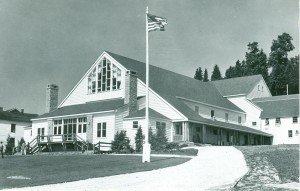
The first building to be completed was the 800-seat theater. MRA used song and drama to present its message, and produced its own plays. The theater was designed by architect William Woolett of Los Angeles. Logs for the rafters came from Bois Blanc Island.
1956 The Great Hall and “A” and “B” Residences
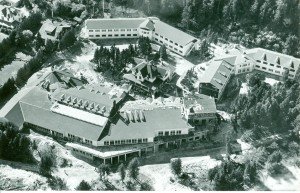
The Great Hall contained the massive cylindrical lobby, meeting rooms and dining facilities. Two dormitories (“A” and “B”) were built on the hillside above. The entire complex initially surrounded the larger Sheeley Cottage, “Cedar Point,” which was razed by 1959.
1957 Building “C” (Main or Straits Lodge)
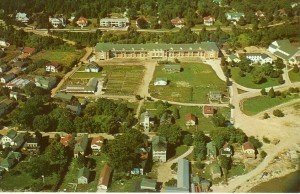
With ever-increasing numbers attendees at the conferences more housing was needed and the large brick dormitory was completed to the west of Mission House. It contained guest rooms and impressive wood-paneled lounges.
1960 Film Studio
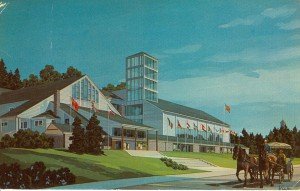
The largest construction project, designed by architect Edwin B. Cromwell of Little Rock, Arkansas, was the film studio. MRA had begun producing film-versions of its plays a few years earlier. A state of the art facility, it included a motion picture sound stage, recording studio, processing laboratories, and carpenter shops. It was attached to the east end of the theater and saw the destruction of the barn and movement of the west Sheeley Cottage. The Bungalow, to the east of the studio, was torn down by 1965. The studio is the largest steel-frame structure on the island.
1965-66 Howard Library and Clark Center
Following the deaths of Frank Buchman in 1961 and his successor Peter Howard in 1965, the leadership of MRA decided to convert the center on Mackinac Island into a liberal arts college. This would allow using the facility on a year-round basis. Two additional buildings were added: The Peter Howard Memorial Library and the Clark Center classroom building. Large steel-frame and concrete structures both had a modern character, unlike most of the earlier Colonial Revival structures.
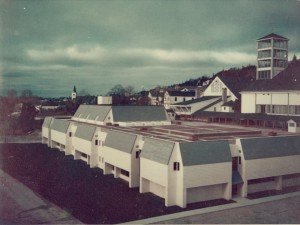
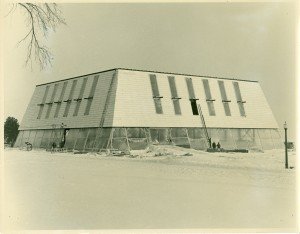
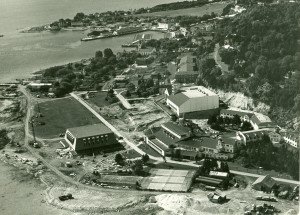
The college did not prove successful and closed after graduating its first class on June 20, 1970. The following year MRA officially ceased activity on Mackinac Island and divested itself of its island holdings, selling most of it to Rev. Rex Humbard of Akron, Ohio. Rev. Humbard’s attempts to operate a resort and revive the college were short lived, owing to other financial difficulties in his organization, and ceased in 1973. In 1977 a Dallas-based property and investment firm purchased the property and converted into the “Mackinac Hotel and Conference Center.” Fearing that the historic 1825 Mission House would not survive much longer, the Mackinac Island State Park Commission purchased it from the Humbard organization and restored it. The Mackinac Hotel was sold in 1987 and the name changed to Mission Point Resort. Within a few years the new owners tore down the Howard Library.









